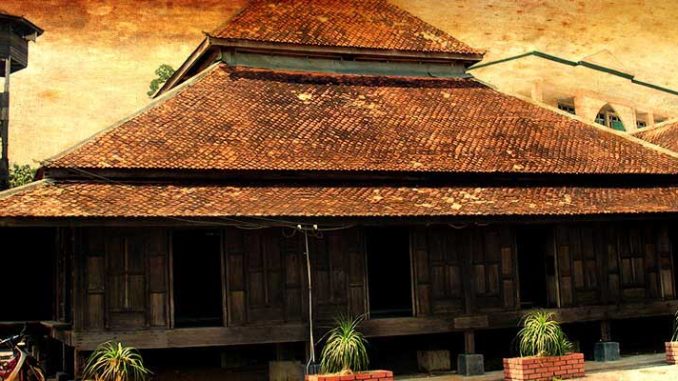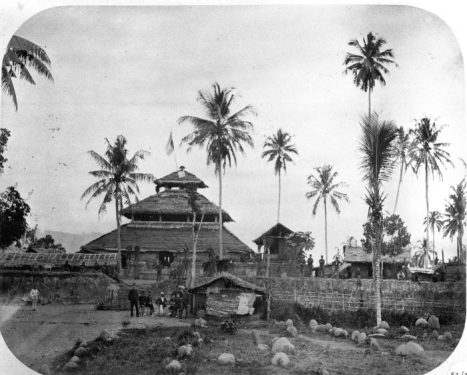
One morning some five years ago, the women were gathered in the home of an older woman called Jamalan. It was a thatch-roofed wooden house built on posts typical of most of Southeast Asia, with a veranda to receive visitors and an enclosed elevated area reserved for privacy – not what one might ordinarily think of as Islamic although its inhabitants were.
Islam, after all, did not impose its forms in this part of the world, adapting instead to existing cultures, including one that, at its height, produced the exquisite stupa of Borobudur and the Hindu shrine (or candi) in Prambanan, Java, Indonesia. The marks of Islamic art in Southeast Asia are subtly embedded in expressions of an artistic heritage that preceded waves of foreign influences from the Asian mainland and beyond. Southeast Asia is, in fact, noted for strong cultural moorings, with influences from China, India, and other parts overlaid on the indigenous without diminishing it.
Southeast Asia was not always at the receiving end of exogenous, or foreign, cultures. The great seafarers of the islands rode the waves across the seas, reaching as far as the island of Madagascar off the African continent, sharing their culture along the way. In Madagascar, for instance, the art of textile weaving is more akin to the craft of women in the Indonesian archipelago than to techniques used by women on the African mainland. The “Malay” forge was also adapted in Madagascar, its metallurgical tradition closer to those of the T’boli of Lake Sebu than to the traditions of other African tribes.
Back in Barangay Oring-oring, the women weave pandanus mats of vibrant colors in various types of patterns – from simple checks and plaids to more intricate combinations of zigzag, trapezoids, triangles, and other geometric shapes in tapestry-like weave. Like their sisters in Laminusa and Ungus Matata in Sulu, the Oring-oring women weave beauty into a domestic article that can lure even the moon and stars with its intricacy and delicacy.
Without Icons
There is a saying or hadith, “God is beautiful and He loves beauty.” Beauty in the Islamic sense is, however, not beauty in the modern sense. Titus Burckhardt, a scholar of Islam and the sacred arts who was once adviser to the Unesco on the preservation of the Islamic city of Fez, says: “Art to the Muslim is a ‘proof of the Divine existence’ only to the extent that it is beautiful, without showing the marks of subjective, individualistic inspiration. Its beauty must be impersonal like that of the starry sky.” Such a statement may not sit comfortably in the modern mindset’s “art is for art’s sake” where the genius of an artist relies on individual imagination and “originality.”
Instead, Islamic art is directed toward the experience of Divine Unity in multiplicity and multiplicity in Divine Unity. One gets a sense of this art in Burckhardt’s words – “the entirety of plastic arts in Islam [as] essentially the projection into the visual order, of certain aspects or dimensions of Divine Unity.”
The attempt to find clear visual patterns of Islamic art in Oring-oring may not have been successful. A pattern of another kind has already begun to emerge in the simple flow of a life with apparently less dichotomy between the sacred and the profane as one observes in the mosques, indistinguishable from homes and similarly embellished domestic and religious articles.
Another eminent Islamic scholar, Seyyed Hossein Nasr, says art in Islam “is not considered a luxury, but an integral part of life itself… everything has its special art [fann] by virtue of which it can be made or done correctly.” The mat is a case in point – its own special art as an integral part of life in many communities like Oring-oring. It is “aniconic”—without icons – withdrawing from any attempt at representing the images of humans and animals, even of casting their shadows, if for no other reason than to simplify, rather than distract, human approach to the Divine.
Relief panels in a sixteenth-century mosque in Mantingan, Eastern Java, for instance, adapts a florid interpretation of plant and animal forms similar to Hindu and Buddhist motifs. Such stylization conforms to the Islamic aniconism, instead resonating with the rhythm and flow of the biomorphic patterns of islimi, the arabesque intended to lead the eye, heart, and mind toward the Divine. Such a tradition of artistic carving depicting plant form motifs is found in the Southern Philippines, particularly in Maranao and Sulu.
Gentle Islam
David Szanton, an American who surveyed the art of Sulu in the 1970s, noted okir as “the act of carving, and a particular type of curvilinear design, which combines stylized scroll, leaf and vine elements in a seemingly infinite range of abstract variation.” This type of carving is found in objects such as Quran stands and containers and also as ornamentation in Maranao houses. Like the okir, awan larat, a traditional Malay form of wood carving, conforms with Islamic principles of aniconism as well as of space, proportion, and beauty beyond the physical, toward art’s spiritual dimension.
It is replete with calligraphy, geometry, and islimi. The absence of representational figures is an attempt at an objective approach to ornamentation emanating from sacred geometry. Although this intent may be present in Southeast Asia, these elements may not be as visible or as clear as they are in Middle Eastern countries. This is because Southeast Asian Islamic art is the product of adaptation and culturally sensitive application of Islamic principles. Its origins are after all a very special kind of Islam – Sufism, also known as the “gentle Islam” that arrived in the islands of Southeast Asia with Muslim traders and holy men, many of them from Gujarat in India, as early as the twelfth century.
Many of them settled in the entrepots of trade and commerce that grew into the great port cities of the Malay world. It was, however, not until the conversion of the Sultan of Malacca to Islam in the fifteenth century that it flourished throughout Island Southeast Asia.
Sufi teachers who first came to this region respected the Malay language, translating many Sufi classics from Arabic and Persian to Malay, making it one of the major Islamic languages. Arabic script in the Malay language is inscribed in tombstones of the first Muslim settlers.
Embodying the written word of the Quran, Arabic script or calligraphy is in the highest order of expression in Islamic art. Martin Lings, former keeper of Islamic Manuscripts at the British Museum, often reminds audiences at his annual lectures on Islamic Illumination that if the Word was made Flesh for Christianity, the Word was made Book in Islam. Fine examples of Southeast Asian Quranic manuscripts are found at the Islamic Arts Museum in Kuala Lumpur, Malaysia.

Cultural Diversity
The first mosques (masjid) in Southeast Asia were made of timber, built on a square base and capped with multitiered thatched roofs, quite unlike what one oriented to the better-known models of Islamic architecture in the Near and Middle East might expect.
In the Far East, where the climate is tropical and before the advent of air conditioning, the mosque was typically built as a house elevated on four posts. There are even accounts claiming that the floor plan and elevation of early Southeast Asian mosques were not unlike those of early cockfight arenas.
Art historians cite various examples of Islamic architecture in Southeast Asia as a continuation of earlier traditions. The artistic traditions of Majapahit live on in the sixteenth-century minaret of Kudus in Java and the gateway to the mosque at Sendang Duwur in East Java, filled with the nature motifs found in East Javanese relief.
A traditional mosque in Aceh, dated to about the nineteenth century, has a roof reminiscent of an older one in Brunei, its five tiers symbolizing the Five Pillars of Islam.
Unlike their Middle Eastern counterparts, the juxtaposition of calligraphy, geometric patterns, and islimi is not featured in the timber buildings of early Southeast Asian mosques. Many contemporary mosques, however, echo this feature in their interiors.
The regional character of Islamic art in Southeast Asia instead mirrors respect for cultural diversity in the ummah. Thus, the region’s early art and architecture evidence Islamic integration with older religious traditions. Here, through the centuries, Islam continued to receive and evolve with other cultural influences, much as it did in the past. Today its greatest challenge is how to retain its universal, sacred language as it moves into the post-modern, post-industrial Information Age.
Patricia Ma. Araneta / Newsbreak
Kyoto Review of Southeast Asia. Issue 5 (March 2004). Islam in Southeast Asia
